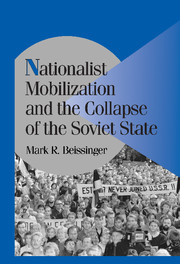Book contents
- Frontmatter
- Contents
- Illustrations
- Tables
- Acknowledgments
- 1 FROM THE IMPOSSIBLE TO THE INEVITABLE
- 2 THE TIDE OF NATIONALISM AND THE MOBILIZATIONAL CYCLE
- 3 STRUCTURING NATIONALISM
- 4 “THICKENED” HISTORY AND THE MOBILIZATION OF IDENTITY
- 5 TIDES AND THE FAILURE OF NATIONALIST MOBILIZATION
- 6 VIOLENCE AND TIDES OF NATIONALISM
- 7 THE TRANSCENDENCE OF REGIMES OF REPRESSION
- 8 RUSSIAN MOBILIZATION AND THE ACCUMULATING “INEVITABILITY” OF SOVIET COLLAPSE
- 9 CONCLUSION: NATIONHOOD AND EVENT
- Appendix I PROCEDURES FOR APPLYING EVENT ANALYSIS TO THE STUDY OF SOVIET PROTEST IN THE GLASNOST' ERA
- Appendix II SOURCES FOR THE COMPILATION OF EVENT DATA IN A REVOLUTIONARY CONTEXT
- Index
- Titles in the series
4 - “THICKENED” HISTORY AND THE MOBILIZATION OF IDENTITY
Published online by Cambridge University Press: 18 November 2009
- Frontmatter
- Contents
- Illustrations
- Tables
- Acknowledgments
- 1 FROM THE IMPOSSIBLE TO THE INEVITABLE
- 2 THE TIDE OF NATIONALISM AND THE MOBILIZATIONAL CYCLE
- 3 STRUCTURING NATIONALISM
- 4 “THICKENED” HISTORY AND THE MOBILIZATION OF IDENTITY
- 5 TIDES AND THE FAILURE OF NATIONALIST MOBILIZATION
- 6 VIOLENCE AND TIDES OF NATIONALISM
- 7 THE TRANSCENDENCE OF REGIMES OF REPRESSION
- 8 RUSSIAN MOBILIZATION AND THE ACCUMULATING “INEVITABILITY” OF SOVIET COLLAPSE
- 9 CONCLUSION: NATIONHOOD AND EVENT
- Appendix I PROCEDURES FOR APPLYING EVENT ANALYSIS TO THE STUDY OF SOVIET PROTEST IN THE GLASNOST' ERA
- Appendix II SOURCES FOR THE COMPILATION OF EVENT DATA IN A REVOLUTIONARY CONTEXT
- Index
- Titles in the series
Summary
A person who changes his viewpoint depending on changes in life rises in the estimation of those around him.
Leonid Kravchuk, April 1991In May 1987, when glasnost' was gathering steam in Moscow but had yet to reach the provinces, I traveled to Soviet Moldavia with my wife Margaret, a fluent speaker of Romanian. Our trip was as Orwellian an experience as I had encountered in my many stays in the USSR. Every minute of our visit was carefully regulated to exclude uncontrolled contact with the population and to ensure our “proper” impressions concerning the loyalties of the local population. We were assigned a multiethnic team to orchestrate our stay: a Moldovan, whose genuine enthusiasm for the achievements of Soviet power (as well as demonization of Romania's connection with Moldavia) surpassed even that of the Russians surrounding him; a Jew, whose scholarly work was far removed from the themes of the visit, but whose suspicious questioning seemed designed to probe the limits of my own Jewish identity; and a Ukrainian, whose main purpose seems to have been to watch over the Moldovan and the Jew. We returned over three years later – in December 1990 – after two years of upheaval in Moldova and a revolution in neighboring Romania. By that time, our Moldovan host had become a prominent leader of the popular front, famous throughout the republic for his fiery nationalist speeches at mass rallies against Moscow's “colonial” policies in the republic; the Jew was in the process of emigrating to Israel; and the Ukrainian had already moved back to Ukraine.
- Type
- Chapter
- Information
- Nationalist Mobilization and the Collapse of the Soviet State , pp. 147 - 199Publisher: Cambridge University PressPrint publication year: 2002

